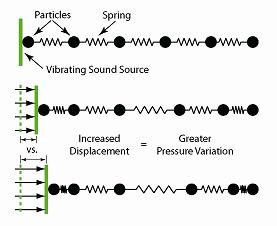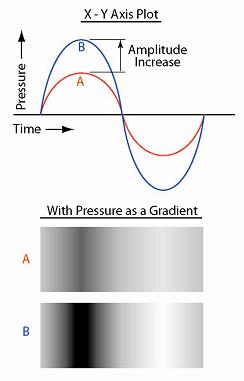In the preceding post I explained how sound waves are created by a vibrating or pulsing source and how they are conducted by a sound conducting media. Amplitude, Frequency and Wavelength are characteristics of sound waves that will be important to understand as we progress to an understanding of ultrasonics. Today’s topic is amplitude.

- The above illustrates the effect of increasing the displacement or pressure of a sound source. Notice that the higher amplitude sound creates a wider range of pressure variation as indicated by the compression and extension of the springs.
Amplitude –
Amplitude is the same as what we commonly call the loudness of a sound. Increasing the displacement of a vibrating source or increasing in the pressure produced by a pulsing source results in higher amplitude (louder) sound. If the displacement of the sound source increases, the differences in the pressure (compression) and tension (rarefaction) become greater as indicated by the springs in the model in the accompanying illustration. Larger displacement of the source requires additional energy to displace the particles of the conducting media resulting in an increasing in the distances the particles must move to conduct the higher amplitude sound wave. Amplitude is a function of power. In general, a higher powered source will produce a higher amplitude sound wave. The true relationship depends on the efficiency with which the sound source transforms the source energy into sound waves.
If you are short of particles and springs, a slinky toy can be used to illustrate the mechanics of a sound wave. Attaching some beads or ping pong balls to the edges of the coils of the slinky spring may help in the visualization.

Although the particle and spring and the slinky model are useful in the fundamental understanding of sound, we should, from now on, start expressing things in more scientific terms. The graphs in the illustration to the left show the variation in pressure at any given point in the sound conducting media vs. time. If the pressures during the passage of a sound wave are recorded and charted as shown with the “X” axis representing time, the “Y” axis representing pressure, the amplitude of the pressure increases as the displacement of the source increases, hence the term amplitude. In the gradient graph, the darker color relates to higher pressure and the lighter color relates to lower pressure. Notice how the darker color is darker and the lighter color is lighter in the case of higher amplitude sound. The gradient graph is useful in illustrating many effects relating to sound waves.
Decibels –
The amplitude or loudness of sound is commonly expressed and measured in units called decibels (dB). The decibel scale is logarithmic, not linear, so that an increase of 10 dB (60 dB to 70 dB for example) actually indicates that a sound is generated with 10 times the power and, as a result, is 10 times as intense. Reducing the intensity of a sound by 3 dB requires reducing the power by approximately 50%. More information is available at – Wikipedia.com
Things to think about – The sound level in an environment is the result of all of the simultaneous sound sources in the area and can never be lower than that of the highest intensity source. If two sources producing the same sound intensity are operating simultaneously in the same environment, the resultant sound intensity is higher than that produced by either one individually.
60 dB + 60 dB = 63 dB
80 dB + 80 dB = 83 dB
The total sound level produced by two sources with different intensity levels is usually only slightly higher than that of the higher of the two. For Example:
60.0 dB + 70.0 dB = 70.4 dB.
Introducing an additional sound source to an environment will always result in an increase in overall sound level in that area. In short, if the ambient noise level is already 80 dB, introducing another sound source, even if it operates at 65 or 70 dB, will increase the sound level in the area. Ten sound sources, each producing 60 dB of sound, does not equal an environment where the sound level is 60 dB!
– FJF –



 English
English Spanish
Spanish Chinese
Chinese Canada
Canada Mexico
Mexico United Kingdom
United Kingdom



